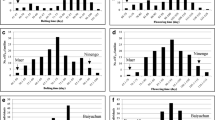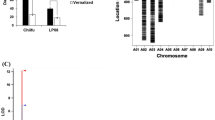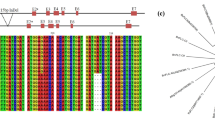Abstract
We investigated the molecular basis of an extremely late bolting, non-heading ‘Leafy Green Parental Line No. 2 (Tsukena No. 2)’, to obtain suitable DNA markers for breeding the late bolting trait in Chinese cabbage (Brassica rapa L. ssp. pekinensis). We found that Tsukena No. 2 contains a ~5 kbp large insertion near the 5′ end of the first intron of BrFLC2, BrFLC3 and BrFLC3′, which are homologs of an Arabidopsis repressor gene for floral transition, FLOWERING LOCUS C (FLC). The transcript abundance of BrFLC1 in Tsukena No. 2 was repressed during cold exposure to the same level as found in a mid-season bolting commercial F1 variety “Muso” (heading Chinese cabbage) and an early-bolting parent of commercial F1 varieties, “Early” (Sakata Co.), whereas repression of BrFLC2 and BrFLC3 containing the large insertion was weak. Furthermore, QTL analysis of a F2 population derived from the Tsukena No. 2 × “Early” revealed that polymorphisms at the BrFLC2 and BrFLC3 loci explained 46.0 and 9.9 % of the phenotypic variation in the bolting time of vernalized plants, respectively. In Arabidopsis, cold-induced repression of FLC and maintenance of that repression are associated with the first intron of FLC. Our study suggests that a naturally occurring large insertion in the first intron resulted in weak repression of BrFLC2 and BrFLC3 during cold exposure and therefore explains the extremely late bolting of the Tsukena No. 2 cultivar.



Similar content being viewed by others
References
Ajisaka H, Kuginuki Y, Yui S et al (2001) Identification and mapping of a quantitative trait locus controlling extreme late bolting in Chinese cabbage (Brassica rapa L. ssp. pekinensis syn. campestris L.) using bulked segregant analysis. Euphytica 118:75–81
Alexandre CM, Hennig L (2008) FLC or not FLC: the other side of vernalization. J Exp Bot 59:1127–1135
Altschul SF, Gish W, Miller W et al (1990) Basic local alignment search tool. J Mol Biol 215:403–410
De Lucia F, Crevillen P, Jones AME et al (2008) A PHD-polycomb repressive complex 2 triggers the epigenetic silencing of FLC during vernalization. Proc Natl Acad Sci USA 105:16831–16836
Elers B, Wiebe HJ (1984) Flower formation of Chinese cabbage. I. Response to vernalization and photoperiods. Sci Hortic 22:219–231
Hatakeyama K, Horisaki A, Niikura S et al (2010) Mapping of quantitative trait loci for high level of self-incompatibility in Brassica rapa L. Genome 53:257–265
Heo JB, Sung S (2011) Vernalization-mediated epigenetic silencing by a long intronic noncoding RNA. Science 331:76–79
Hu GL, Hu ZL, Li Y et al (2011) A splicing site mutation in BrpFLC1 and repressed expression of BrpFLC genes are associated with the early flowering of purple flowering stalk. Russian J Plant Physiol 58:431–438
Jack T (2004) Molecular and genetic mechanisms of floral control. Plant Cell 16:S1–S17
Kakizaki T, Kato T, Fukino N et al (2011) Identification of quantitative trait loci controlling late bolting in Chinese cabbage (Brassica rapa L.) parental line Nou 6 gou. Breed Sci 159:151–159
Kim SY, Park BS, Kwon SJ et al (2007) Delayed flowering time in Arabidopsis and Brassica rapa by the overexpression of FLOWERING LOCUS C (FLC) homologs isolated from Chinese cabbage (Brassica rapa L. ssp. pekinensis). Plant Cell Rep 26:327–336
Lee I, Amasino RM (1995) Effect of vernalization, photoperiod, and light quality on the flowering phenotype of Arabidopsis plants containing the FRIGIDA gene. Plant Physiol 108:157–162
Lempe J, Balasubramanian S, Sureshkumar S et al (2005) Diversity of flowering responses in wild Arabidopsis thaliana strains. PLoS Genet 1:109–118
Li F, Kitashiba H, Inaba K, Nishio T (2009) A Brassica rapa linkage map of EST-based SNP markers for identification of candidate genes controlling flowering time and leaf morphological traits. DNA Res 16:311–323
Lou P, Zhao J, Kim JS et al (2007) Quantitative trait loci for flowering time and morphological traits in multiple populations of Brassica rapa. J Exp Bot 58:4005–4016
Lowe J, Moule C, Trick M, Edwards KJ (2004) Efficient large-scale development of microsatellites for marker and mapping applications in Brassica crop species. Theor Appl Genet 108:1103–1112
Michaels SD, Amasino RM (1999) FLOWERING LOCUS C encodes a novel MADS domain protein that acts as a repressor of flowering. Plant Cell 11:949–956
Mouradov A, Cremer F, Coupland G (2002) Control of flowering time: interacting pathways as a basis for diversity. Plant Cell 14:S111–S130
Murray MG, Thompson WF (1980) Rapid isolation of high molecular weight plant DNA. Nucleic Acids Res 8:4321–4325
Osborn TC, Kole C, Parkin IAP et al (1997) Comparison of flowering time genes in Brassica rapa, B. napus and Arabidopsis thaliana. Genetics 146:1123–1129
Schmitz RJ, Amasino RM (2007) Vernalization: a model for investigating epigenetics and eukaryotic gene regulation in plants. Biochim Biophys Acta 1769:269–275
Schranz ME, Quijada P, Sung SB et al (2002) Characterization and effects of the replicated flowering time gene FLC in Brassica rapa. Genetics 162:1457–1468
Sheldon CC, Burn JE, Perez PP et al (1999) The FLF MADS box gene: a repressor of flowering in Arabidopsis regulated by vernalization and methylation. Plant Cell 11:445–458
Sheldon CC, Rouse DT, Finnegan EJ et al (2000) The molecular basis of vernalization: the central role of FLOWERING LOCUS C (FLC). Proc Natl Acad Sci USA 97:3753–3758
Sheldon CC, Conn AB, Dennis ES, Peacock WJ (2002) Different regulatory regions are required for the vernalization-induced repression of FLOWERING LOCUS C and for the epigenetic maintenance of repression. Plant Cell 14:2527–2537
Simpson GG, Gendall AR, Dean C (1999) When to switch to flowering. Annu Rev Cell Dev Biol 15:519–550
Sung S, Amasino RM (2006) Molecular genetic studies of the memory of winter. J Exp Bot 57:3369–3377
Sung S, He Y, Eshoo TW et al (2006) Epigenetic maintenance of the vernalized state in Arabidopsis thaliana requires like heterochromatin protein 1. Nat Genet 38:706–710
Suwabe K, Iketani H, Nunome T et al (2002) Isolation and characterization of microsatellites in Brassica rapa L. Theor Appl Genet 104:1092–1098
Suwabe K, Iketani H, Nunome T et al (2004) Characteristics of microsatellites in Brassica rapa genome and their potential utilization for comparative genomics in Cruciferae. Breed Sci 54:85–90
Suwabe K, Tsukazaki H, Iketani H et al (2006) Simple sequence repeat-based comparative genomics between Brassica rapa and Arabidopsis thaliana: the genetic origin of clubroot resistance. Genetics 173:309–319
Teutonico RA, Osborn TC (1995) Mapping loci controlling vernalization requirement in Brassica rapa. Theor Appl Genet 91:1279–1283
Van Ooijen J (2004) MapQTL 5, Software for the mapping of quantitative trait loci in experimental populations. Kyazma B. V, Wageningen
Van Ooijen J (2006) JoinMap 4, Software for the calculation of genetic linkage maps in experimental populations. Kyazma B. V, Wageningen
Voorrips RE (2002) MapChart: software for the graphical presentation of linkage maps and QTLs. J Hered 93:77–78
Werner JD, Borevitz JO, Uhlenhaut NH et al (2005) FRIGIDA-independent variation in flowering time of natural Arabidopsis thaliana accessions. Genetics 170:1197–1207
Wu J, Wei K, Cheng F et al (2012) A naturally occurring InDel variation in BraA. FLC. b (BrFLC2) associated with flowering time variation in Brassica rapa. BMC Plant Biol 12:151
Yang TJ, Kim S, Kwon SJ et al (2006) Sequence-level analysis of the diploidization process in the triplicated FLOWERING LOCUS C region of Brassica rapa. Plant Cell 18:1339–1347
Yuan YX, Wu J, Sun RF et al (2009) A naturally occurring splicing site mutation in the Brassica rapa FLC1 gene is associated with variation in flowering time. J Exp Bot 60:1299–1308
Yui S, Hida K (2002) Effects of plant stages on bolting of the Breeding Line “Leafy Green Parental Line No.2” (Brassica rapa L. pekinensis group). J Japan Soc Hortic Sci 71:192–196
Yui S, Yoshikawa H (1991) Bolting resistant breeding of Chinese cabbage. 1. Flower induction of late bolting variety without chilling treatment. Euphytica 52:171–176
Yui S, Yoshikawa H (1992) Breeding of bolting resistance in Chinese cabbage—critical day length for flower induction of late bolting material with no chilling requirement. J Japan Soc Hortic Sci 61:565–568
Zhao J, Kulkarni V, Liu N et al (2010) BrFLC2 (FLOWERING LOCUS C) as a candidate gene for a vernalization response QTL in Brassica rapa. J Exp Bot 61:1817–1825
Acknowledgments
This study was supported by “Development of extremely late bolting cultivars in Brassicaceae using molecular analysis of a breeding material which requires long-day for bolting”, Adaptable and Seamless Technology Transfer Program through Target-driven Research & Development, Japan Science and Technology Agency. We would like to thank to Professor Ryo Ohsawa in the University of Tsukuba for support of the construction of linkage map and QTL analysis. We also would like to thank to Dr. Karen S. for a review of our manuscript.
Author information
Authors and Affiliations
Corresponding author
Electronic supplementary material
Below is the link to the electronic supplementary material.
Rights and permissions
About this article
Cite this article
Kitamoto, N., Yui, S., Nishikawa, K. et al. A naturally occurring long insertion in the first intron in the Brassica rapa FLC2 gene causes delayed bolting. Euphytica 196, 213–223 (2014). https://doi.org/10.1007/s10681-013-1025-9
Received:
Accepted:
Published:
Issue Date:
DOI: https://doi.org/10.1007/s10681-013-1025-9




